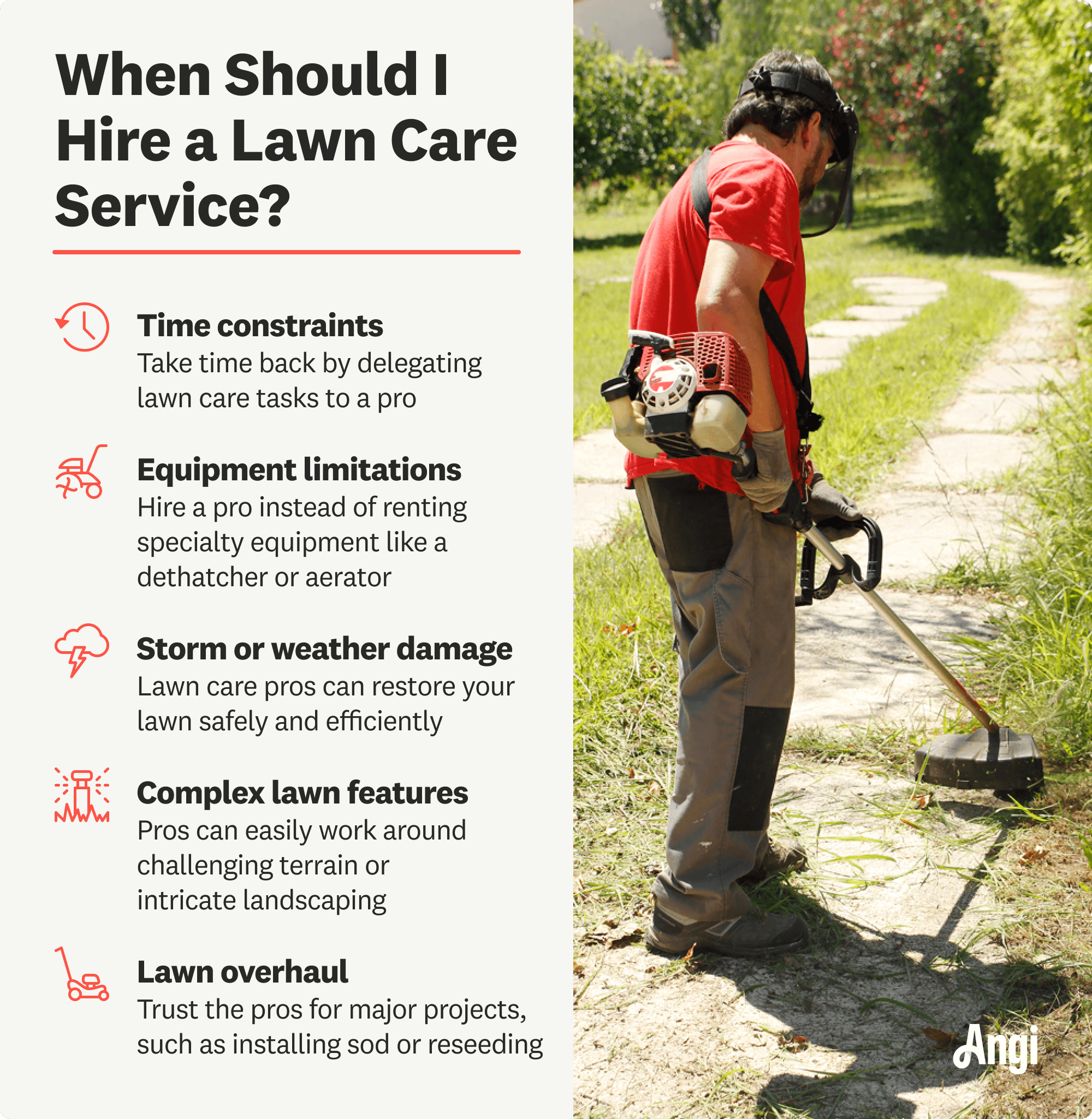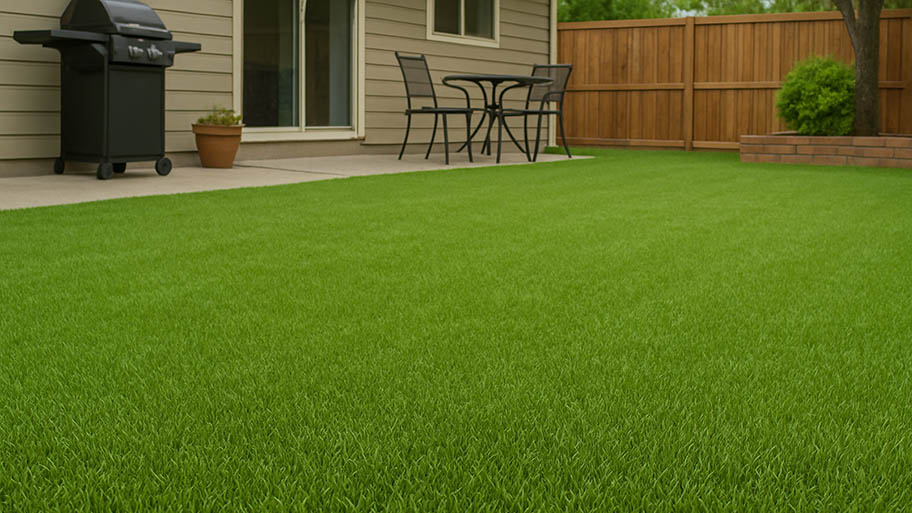
Removing an old lawn is often necessary to plant new grass or build a new outdoor structure. Find out what to budget for your lawn removal cost.
Hire a professional lawn care service to diagnose and treat your lawn problems


If you’re struggling to remedy your lawn’s brown patches or overgrown weeds, you’re likely wondering who to call for lawn problems. DIY lawn treatments sometimes work, but only occasionally. In fact, many homeowners misdiagnose their lawn problems and end up causing more harm to their lawns. Hiring a licensed and insured lawn care service is best for properly diagnosing and treating lawn problems. Here’s what you can expect when hiring a lawn care professional.

When dealing with any lawn issue, your best bet is to hire a lawn care service near you. Routine lawn care costs between $100 to $500, depending on the service, but having a professional correctly identify and treat your lawn problems is well worth it. Here are the benefits of hiring a lawn care service:
Pros can properly diagnose and treat your lawn care problems
Customized services
Local knowledge
Lawn care pros have extensive knowledge and experience
Pros come with the proper equipment and tools
Pros provide preventative measures and maintenance
Pros can help with lawn watering and sprinkler system installation
Many offer discounts if you sign long-term contracts
If you’re handy and have the proper tools and supplies, you can DIY certain lawn care elements yourself. For example, most homeowners can tackle lawn mowing and leaf removal. However, we recommend hiring a lawn care pro if you have more severe lawn problems, such as patchy grass, thinning grass, pest infestation, weed growth, and lawn fungus.
You could waste a lot of time and money trying to resolve a problem that requires professional inspection and treatment. In addition, you could also cause further harm to your lawn. Let’s say your lawn requires regular watering, and you instead use insecticide to treat the problem. It’s much easier to hire a professional from the start and avoid treating your lawn with the incorrect remedies.

Yes, you can hire a local landscaper to help with some of your lawn issues. However, some landscaping professionals specialize in services like hardscaping and irrigation, so it’s best to clarify the tasks you need help with when hiring. You can expect to pay $3,500 on average for landscaping services, but smaller jobs will cost as low as $200.
Landscapers can help with specific lawn problems, such as:
Soil replacement
Proper lawn fertilization
Upkeep and maintenance
Xeriscaping
Landscape design
Tree, bush, and shrub planting
Lawn care professionals have the tools, equipment, knowledge, and experience to diagnose and correct lawn problems. Depending on where you live, you might encounter brown patches, thin grass, lawn fungus, pest infestation, and more. Here’s how lawn care professionals treat these common lawn problems:
When your grass won’t grow, there is often insufficient sunlight. A lawn care professional will likely recommend professional tree trimming to increase sunlight reaching your lawn, helping the grass grow. You can expect to pay between $270 and $1,800 for tree trimming.
Bleach patches and yellow grass are common in areas with high humidity. Luckily, there are some simple remedies to bring your grass back to life, including:
Keep lawn watering to a minimum.
Apply a nitrogen-rich fertilizer to the grass, which will help your lawn recover.
Don’t cut your lawn too short.
You might have brown patches on your lawn. Brown patches can happen for several reasons, including nitrogen burns, overwatering, poor soil drainage, improper maintenance, and more. Here’s how lawn pros repair brown patches:
Dethatch and aerate your lawn annually.
Water your lawn early in the day so your grass can soak in moisture.
Apply vital nutrients to your lawn.
If you regularly fertilize your lawn but it doesn’t make a difference, the problem could be your soil’s pH balance. Here’s how a lawn care pro will fix this issue:
A pro will perform soil testing, which costs $600 to $2,000.
Once your soil’s pH level is tested, pros will add the proper amendments to bring your soil to the right level.
A pro may also add lime amendments, which raise the pH of your soil, making it more alkaline.
Pests, such as grubs, chinch bugs, aphids, armyworms, and sod webworms, love to feed on the roots of grass and organic soil matter. These common grass bugs and lawn pests can quickly turn your grass brown and wilt the blades. In addition, skunks, birds, and raccoons also love to feast on these bugs—so you’ll have to contend with those animals. Here’s how lawn pros identify and treat pest infestations:
A pro will walk along the grass to see if it feels spongy.
Pros will pull up a handful of grass. If it comes up quickly, it’s because pests are eating away at the roots.
A pro will then treat your lawn with a grub guard or an organic pesticide to prevent bugs and pests from chewing on your lawn.
Compacted soil and thatch often cause grass to thin. Compacted soil means your lawn can’t breathe, and little sunlight, water, and nutrients reach the roots. Because your grass isn’t taking in vital substances, it will start to thin and lose its beautiful green coloration.
Pros will perform lawn aeration, which costs $75 to $200. Lawn aeration is the process of poking hundreds of small holes in your yard, which then allows sunlight, water, and vital nutrients to reach the grassroots.
Lawn fungus and disease thrive in moist environments, heat, drought, and compacted soil. To keep fungus at bay, many lawn care professionals will apply several lawn treatments, including:
Lawn aeration
Adding specialized fertilizer
Applying fungicides to your lawn
Seeding your lawn in the fall
Many different types of weeds can show up on your lawn. So, there is no one-size-fits-all approach to getting rid of them. Depending on the type of weed, lawn care pros may apply the following treatments:
Pre-emergents
Weed shield herbicides
Chemical-grade weed killer (not found in stores)
Mowing your lawn high
Properly watering your lawn
Preventative annual lawn maintenance
From average costs to expert advice, get all the answers you need to get your job done.

Removing an old lawn is often necessary to plant new grass or build a new outdoor structure. Find out what to budget for your lawn removal cost.

The cost to reseed a lawn can vary depending on the size of your yard and the condition of the soil. We’ll help you figure out the true cost of reseeding or overseeding your lawn, along with whether or not you should hire a professional.

Artificial grass is a low-maintenance alternative to traditional turf. Learn how much artificial grass installation costs and what affects your price.

No one wants to kick back on a hard and dry patch of dirt at the end of the day. Here's how to fix overly dry dirt in your lawn in seven simple steps.

Learn how to remove yard waste properly and efficiently with these methods.

Making grass greener and thicker is easy—when you know how it’s done! Find out how to make your grass green and lush with these simple tips. This guide has everything to know about making grass greener to get a beautiful, healthy lawn.